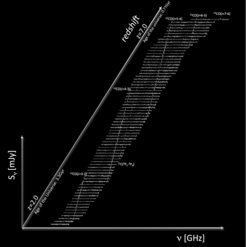Early Universe
Observations at wavelengths between 1.4 and 0.8 mm play a fundamental role in studying the dusty high redshift universe since the signal strength at these wavelengths is almost independent of the redshift. This allows us to study the evolution of galaxies equally well for look-back times when the universe was roughly half of its current age (z~1) back to times just a few hundred Myr after the big bang (z~8). Using continuum surveys from APEX and the South Pole Telescope in synergy with ALMA and NOEMA we investigate the formation of the first massive dust-enshrouded galaxies after the big bang, the formation of galaxy clusters as well as the build-up of the central stellar bulges of galaxies in the era of galaxy assembly and into the era of reionization.
The redshift distribution of mm selected star forming galaxies

Using the Atacama Large Millimeter/submillimeter Array, we have conducted a blind redshift survey in the 3 mm atmospheric transmission window in a complete flux limited sample (S850 > 25mJy) of 81 dust star forming galaxies (DSFGs) selected from the 2500 deg2 South Pole Telescope (SPT) survey. By combining these measurements with ancillary data, the SPT sample is now spectroscopically complete, with redshifts spanning 1.9 < z < 6.9 and a median of z = 3.9 ± 0.2. Comparing the properties of the SPT sources to the unlensed DSFG population, we demonstrate that the SPT-selected DSFGs represent the most extreme infrared- luminous galaxies, even after accounting for strong gravitational lensing. This SPT sample contains roughly half of the known spectroscopically confirmed DSFGs at z > 5, making this the largest sample of high-redshift DSFGs to-date, and enabling the “high-redshift tail” of extremely luminous DSFGs to be measured. Though galaxy formation models struggle to account for the SPT redshift distribution, the larger sample statistics from this complete and well-defined survey will help inform future theoretical efforts.
Proto clusters in the early universe
![Observations at 0.87 mm of the proto-cluster system SPT2349-56 at redshift 4.3 from the Apex telescope (top left) and ALMA towards the center of the cluster (center). The cluster membership is verified by observations of the [CII] emission line (grey spectra).](/6521294/original-1635513135.jpg?t=eyJ3aWR0aCI6MjQ2LCJvYmpfaWQiOjY1MjEyOTR9--1c0702da36c17a5cd24a25d1850e694d475563d3)
Our Universe evolved hierarchically, building up structure gradually from galaxy groups to clusters. Simulations suggest that the highest star-formation rates (SFRs) occurred in the proto-cluster environment with the most massive halos reaching peak SFRs at an earlier epoch than those of lower mass. Massive galaxy clusters are found out to z < 2.0 with stars that formed at even earlier epochs. But observational evidence for proto-cluster formation in such extreme star-formation events at very early epochs (z > 3) has remained elusive until recently.
In a 1.4 mm survey over 2500 deg2, the South Pole Telescope (SPT) discovered a population of rare and mm-bright sources. Our ALMA 870 μm imaging and spectroscopy showed that ∼ 90% of these sources are individual, gravitationally lensed, dusty star-forming galaxies at z ∼ 4. However, ∼ 10% of the SPT sources show no evidence for lensing, are extended even for LABOCA/APEX (19.8’’ resolution), show strong source over-densities of bright 870 μm emitters compared to the field and break-up into individual galaxies with ALMA. They thus show all expected properties of the most active phase of early cluster formation. From our LABOCA and ALMA imaging we have identified in total 9 proto-cluster candidates from the entire 2500 deg2 coverage of the SPT survey. Similar systems are also identified in large scale sub-millimetre surveys from Herschel. Ongoing observational programs aim to identify all individual galaxies and their redshifts to prove that these systems trace indeed proto-cluster formation at z = 3-7.
Links:

![Observations at 0.87 mm of the proto-cluster system SPT2349-56 at redshift 4.3 from the Apex telescope (top left) and ALMA towards the center of the cluster (center). The cluster membership is verified by observations of the [CII] emission line (grey spectra). Observations at 0.87 mm of the proto-cluster system SPT2349-56 at redshift 4.3 from the Apex telescope (top left) and ALMA towards the center of the cluster (center). The cluster membership is verified by observations of the [CII] emission line (grey spectra).](/6521294/original-1635513135.jpg?t=eyJ3aWR0aCI6MzQxLCJmaWxlX2V4dGVuc2lvbiI6ImpwZyIsIm9ial9pZCI6NjUyMTI5NH0%3D--bf5c98f96af4064d069d4d49466035730524793d)